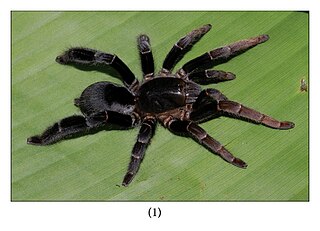
Pterinochilus murinus or the orange baboon tarantula, is a nocturnal spider in the family Theraphosidae that was first described in 1897 by Reginald Innes Pocock. This species is found in Angola, as well as central and southern Africa. It is a member of the subfamily Harpactirinae, baboon spiders.

Ceratogyrus darlingi is a theraphosid spider from southern Africa, mainly Botswana and Lesotho. They reach a body length of about 5 inches (130 mm) and are ash-gray, mud-brown to black. The peltidium features a black foveal horn.

Poecilotheria fasciata, the Sri Lanka ornamental or Sri Lanka ornamental tiger spider, is a large arboreal tarantula. It is endemic to central Sri Lanka.

Aphonopelma moderatum is a species of spider in the family Theraphosidae, found in United States, in the state of Texas. Commonly called the Rio Grande Gold Tarantula as they are found in the Rio Grande Valley of Texas.

Ephebopus cyanognathus, known as the blue fang tarantula, is a species of tarantula. It is endemic to French Guiana. It was first described by Rick C. West and Samuel D Marshall in 2000, and is somewhat commonly kept as pets. As it common name may suggest, they have magnificent blue chelicerae, cyano meaning blue and gnathus meaning jaw. This tarantula is a burrowing spider, though spiderlings of this species have been observed to be semi-arboreal.

Poecilotheria subfusca, or the ivory ornamental, is a spider in the tarantula family, Theraphosidae. It is endemic to Sri Lanka. As of February 2019, the World Spider Catalog regarded Poecilotheria bara as a synonym. Other sources, particularly in the pet trade, have treated highland and lowland forms as distinct species, with the lowland forms being P. bara.

Encyocratella is a monotypic genus of Tanzanian tarantulas containing the single species, Encyocratella olivacea, also known as the Tanzanian black and olive baboon spider. It was first described by Embrik Strand in 1907, and is found in Tanzania.

Avicularia minatrix also known as the Red Slate Pink Toe, Redstripe Pinktoe or Venezuelan Redstripe Tarantula is a species of spider in the family Theraphosidae, found in Venezuela and Brazil. It was first described by Reginald Innes Pocock in 1903, being arboreal in nature and quite reclusive, and also the smallest tarantula of the Avicularia genus.

Harpactira pulchripes, also known as the golden blue-legged baboon spider, is a bright yellow-bodied and metallic blue-legged tarantula found in South Africa. It was first described by Reginald Innes Pocock in 1901. It is a very highly desired tarantula in the European and American tarantula keeping hobby. Its specific name pulchripes is derived from Latin "pulchri" meaning beautiful, and "pes" meaning feet, forming the name beautiful feet.

Chilobrachys fimbriatus, commonly known as the Indian Violet Earth Tiger Tarantula usually shortened to Indian Violet Tarantula, is a species of spider of the genus Chilobrachys. It is endemic to India, and was first described by Reginald Innes Pocock in 1899.

Phormictopus auratus, commonly known as the Cuban bronze tarantula, is a species of tarantula endemic to Cuba. It is found in the provinces of Camagüey, Las Tunas and Holguín. It was first described by David Ortiz and Rogério Bertani in 2005, and was named after golden hairs found in this species, auratus meaning golden in Latin.

Ceratogyrus marshalli, also known as Straight Horned Baboon or Great Horned Baboon Tarantula, is a species of tarantula from the genus Ceratogyrus. It is found in Zimbabwe and Mozambique. It was first described by Reginald Innes Pocock in 1897, as half of the Ceratogyrus genus, they own a impressive horn in the carapace.
Acanthoscurria insubtilis also known as the Bolivian black velvet tarantula, is a spider which was first described by Eugène Simon in 1892. It is found in Bolivia, with some reports also stating in Brazil, though it is mainly in the Bolivian Rainforests.
Pterinochilus lugardi also known Grey starburst baboon, Dodoma baboon, Fort hall baboon or Tanzanian blonde baboon tarantula is a tarantula first described by Reginald Innes Pocock in 1900. They are found all over Southern and Eastern Africa, of course excluding Madagascar.

Harpactira cafreriana otherwise known as the Cape copper baboon or amber baboontarantula spider was first described by Charles Athanase Walckenaer in 1837. It is found in South Africa, being terrestrial or semi-fossorial in nature.

Cyriocosmus perezmilesi otherwise known as the Bolivian dwarf beauty tarantula is a spider which was first described by Radan Kaderka in 2007. It was named in honor of Dr. Fernando Pérez-Miles, and is a fossorial tarantula. As its common name aptly states it is found in Bolivia.

Lyrognathus giannisposatoi sometimes called the Sumatran stout leg tarantula is a tarantula which can be found in Mesuji Regency, Sumatra, Indonesia. It was first described by Steven C. Nunn, Rick C. West in 2013, and is named after Gianni Sposato, who helped with Selenocosmia material, and was of great help to the authors.

Stromatopelma calceatum also known as the featherleg baboon tarantula, was first described by Johan Christian Fabricius in 1793. It is found in West Africa and has gone through a variety of scientific names during its existence.
Heterothele gabonensis, also known as the Gabon blue dwarf baboon tarantula, is a species of tarantula found in Gabon. It was first described by Pierre Hippolyte Lucas in 1858, under the name Mygale gabonensis. They are semi arboreal tarantulas, that web quite a lot. They have also showed some communal tendencies in the form of tolerance for one another over an extended period of time.
Grammostola iheringi also known as the Entre Rios tarantula, it was first described by Keyserling in 1891. They are found in Brazil, and is considered the biggest tarantula in the Grammostola genus.















